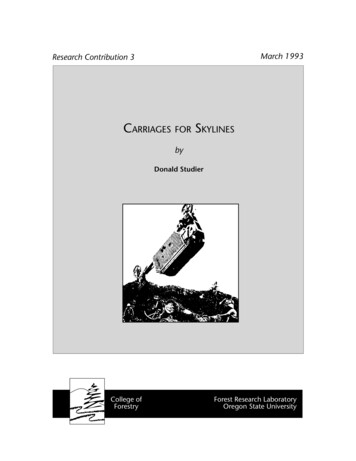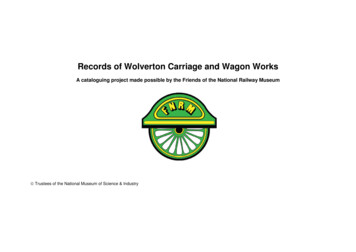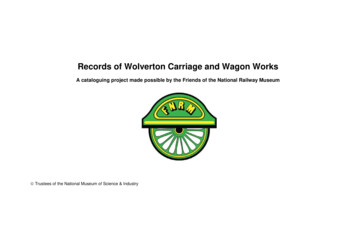
Transcription
March 1993Research Contribution 3Carriages for SkylinesbyDonald StudierCollege ofForestryForest Research LaboratoryOregon State University
The Forest Research Laboratory of Oregon State University was established bythe Oregon Legislature to conduct research leading to expanded forest yields,increased use of forest products, and accelerated economic development ofthe State. Its scientists conduct this research in laboratories and forests administered by the University and cooperating agencies and industries throughoutOregon. Research results are made available to potential users through theUniversity’s educational programs and through Laboratory publications suchas this, which are directed as appropriate to forest landowners and managers, manufacturers and users of forest products, leaders of government andindustry, the scientific community, and the general public.The AuthorDonald Studier is instructor (courtesy), Department of Forest Engineering, College of Forestry, Oregon State University, Corvallis, Oregon, and also loggingengineer, USDA Forest Service, Pacific Northwest Region, Portland, Oregon.DisclaimerThe mention of trade names or commercial products in this publication doesnot constitute endorsement or recommendation for use.To Order CopiesCopies of this and other Forest Research Laboratory publications are availablefrom:Forestry Publications OfficeOregon State UniversityForest Research Laboratory 227Corvallis, Oregon 97331-7401Please include author(s), title, and publication number if known.RecycledPaper
Carriages for SkylinesbyDonald Studier
Table of ContentsAbstract.1Introduction.1Slackpulling Carriages.3Manual. 3Mechanical. 5Pulled by Carriage. 5Pulled by Yarder. 7Non-slackpulling Carriages.10Carriages with Chokers. 10Grapple Carriages. 11Multi-span Skylines.12Summary.13Literature Cited.14ii
AbstractCarriages may be classified as slackpulling or non-slackpulling, and theslackpulling carriages may be further classified by how they accomplishthe slackpulling function. Slackpulling carriages provide the skyline withlateral yarding capability and therefore can be used in a variety of silvicultural prescriptions. Non-slackpulling carriages can include either chokers or grapples and are used in clearcuts. For a skyline system to operateefficiently, the carriage must be matched to the number of lines and theline diameters on the yarder.IntroductionA carriage used in skyline logging is a wheeled device that rides backand forth on the skyline and from which logs are suspended (Mifflin andLysons 1979). Carriages are used on standing, live, and running skylines.An example of a skyline system is shown in Figure 1. For the system tooperate efficiently, the carriage must be matched to the yarder. Three basicrequirements must be met:GuylinesSkylineMainlineSlackpulling LineYarderLandingSkylineCarriageHaulbackBlock & StrapSkidding LineShackleSkyline ExtensionTailsparHaulbackLineGuylineHaulbackBlock & StrapFigure 1. Skyline system with slackpulling carriage.
(a) The skyline sheaves in the carriage must be matched to the skylinediameter. The groove in most sheaves will accept only a narrow rangeof skyline diameters—for example, 3/4 to 1 inch. On many carriages itis relatively easy to replace existing skyline sheaves with sheaves of theproper size, but other carriages will accept only one size of sheave.(b) The yarder must have enough drums to operate the carriage. Somecarriages may require up to four drums.(c) Mainline size must be appropriate. This is very important on slackpulling carriages where the mainline passes through the carriage andbecomes the skidding line, or where it is wrapped on a drum in thecarriage, because the sheaves and drum are sized to a particular linesize. Changing that size may cause unnecessary line wear, damage thesheaves, or lead to loads that exceed the carriage’s design load.There are two categories of carriages—slackpulling and non-slackpulling(Studier and Binkley 1975). Figure 2 classifies and lists some examples ofcurrently used carriages. In slackpulling carriages, a line payed out fromthe carriage can be pulled to the side of the skyline and attached to thelogs, thus increasing the skyline’s lateral yarding capability. This line isreferred to as a skidding line, tong line, or drop line. The skidding linemay be a separate line contained on a drum in the carriage, it may beattached to the mainline from the yarder, or it may be an extension ofthe mainline.Non-slackpulling carriages, which have either chokers or grapplesattached directly to the carriage, are limited in lateral capability to thelength of the choker, or to logs directly under the grapple.Skyline calBacoChristy (4 models)Christy Radio-controlledDanebo M-20 & M-30Pulled byKoller SKA 2.5CarriageMaki Mini-MakUris Gravimat*Boman SkycarWyssenI, II, IIIDanebo DartEagle I, II, IIIEaglet*Golden EagleMaki M-1*ThunderbirdSC-15 & SC-45Pulled byYarderChokerAcme ABerger SkydasherDaneboMiny GMiny G-1Miny G-2Super Miny GDanebo MSP*Danebo S-30 D-L*Danebo S-35 & S-45*Mar 30*Young Ironbird HR300*Skidding line on drum in carriage.Figure 2. Categorization of currently used skyline carriages. GrappleJohnson Y66Mar 303
Slackpulling CarriagesSlackpulling carriages can be used in any type of silvicultural prescription, and they are especially useful for yarding logs in stands where theresidual trees need to be protected from yarding damage. In clearcuts,they reduce the amount of rigging needed by extending the width of theskyline roads. Slackpulling carriages may be further classified by how theyaccomplish the slackpulling function. In manual slackpulling carriages, themainline or skidding line must be pulled through the carriage by hand,whereas mechanical slackpulling carriages use some type of power sourceto pay out the skidding line. The power source may be in the carriage oron the yarder.ManualAll slackpulling carriages must maintain a fixed position on the skylineduring the lateral yarding operation. The manual slackpulling carriages,which are used on either live or standing skylines (Table 1), may use: (a)a haulback line to hold the carriage in place; (b) a hydraulic or mechaniTable 1.1 Slackpulling carriages: ManualMaximumCarriageWeightModel(lbs)Clamps duringskyline yHeavy Duty450ChristyLarge1,500ChristyRadio-cont. 1,000DaneboM-201,460DaneboM-302,250KollerSKA imat680Western FlyerBB1,200Western FlyerDG1,800Western FlyerHW1,500WyssenW-908781 1/25/87/81 1/81 3/81 1/87/81 3/81 1/811 1/81 1/813/41 1/87/81 1/4Mechanical clampStop on skylineStop on skylineStop on skylineStop on skylineRadio-controlledManuallyManuallyMechanical clampStop on skylineManuallyStop on skylineMechanical clampManuallyManuallyManuallyHydraulic clampDUUUUUUUUUUUUUUUDSLLLLLLLSLLLSLLLSCarriage cyclesWyssen1 3/8Hydraulic clampDSCarriage cyclesW-2003,000Carriage cycles4Carriage cyclesCarriage cyclesTables may include models no longer in use.U uphill, D downhill3S standing, L live4To activate the clamp, carriage must either 1) be motionless for a period of time to allow hydraulic pressure to12
cal device in the carriage that clamps it to the skyline (Figure 3); or (c)a separate stopping device clamped to the skyline to which the carriagecan lock (Figure 4). After the carriage is secured in position, the skiddingline, which is actually an extension of the mainline, is manually pulled tothe logs through the carriage, which acts as a block. Because the mainlinehas to be stripped from its drum on the yarder during the slackpullingoperation, a hydraulic device called a slack-kicker may be installed on theyarder to aid in pulling the line from the drum.SheavesSkylineSkyline ClampHydraulic PumpMainlineClamp ReleaseRollerLocking DeviceSkidding LineFigure 3. Manual slackpullingcarriage with skyline clamp.Skyline StopSkyline SheaveRubber ShockCushionSkyline2827/3Cam-releaseChainSkidding LineMainlineMainline Sheave Figure 4. Manualslackpulling carriagewith skyline stop.
Most manual slackpulling carriages have a device inside the carriagethat holds the logs directly beneath the carriage; thus, if the mainline goesslack, the logs will not drop. Manual slackpulling carriages can be operated on a two-drum yarder if the mainline and skyline sizes are correct. Iflogs are to be picked up on the opposite slope, or if yarding is downhill,a haulback line is required. However, either of these situations involvesmanually pulling slack uphill. In thinnings, some operators prefer to usea haulback even for uphill yarding so they can get free of hangups moreeasily by repositioning the carriage.If the yarding distance is to be extended by adding skyline with ashackle (see Figure 1), the carriage should be checked to see whether itcan pass over it. Most of the manual slackpulling carriages that clamp willnot pass over a shackle. A skyline extension may be spliced rather thanshackled, allowing use of a wider selection of carriages.MechanicalMechanical slackpulling carriages use a power source to pay out theskidding line from the carriage. The power source may be located in thecarriage or at the yarder.Pulled by carriagePower sources for carriage-powered carriages (Table 2) have includeddiesel engines, propane engines, hydraulic motors, and springs. No matterwhat type of power is used, these carriages operate in one of two ways:(a) the skidding line is an extension of the mainline and the power sourcepays out the line, but the yarder pulls it in once it is attached to the logs(Figure 5); or (b) the skidding line is contained on a drum in the carriageand the power source both pays out the line and winches it in (Figure 6).Skyline g LineEngineSlackpullerFigure 5. Mechanical slackpulling carriage with skidding line an extension of the mainline. Power source for pulling slack in carriage.
Table 2. Mechanical slackpulling carriages: Slackpulled by carriage1WeightCarriageModel(lbs)Maximumskyline sizeYard.(inches)direc. 2Line capacity ofself-containedskidding drum (ft)3RemarksBergerSkyhawk3,8001 3/8U, D325' of 3/4"BomanSky Car I9,0001 3/4U, D400' of 3/4"BomanSky Car II7,1001 1/2U, D400' of 3/4"BomanSky Car III6,6001 1/4U, D400' of 3/4"DaneboDart3,1001 1/4U–DaneboM 1103,8001 1 7/8U, D380' of 3/4"EagleI4,8001 1/2U–EagleII2,6001 1/8U–EagleIII3,6001 1/4U–EagleEaglet1,2007/8U–EagleGolden Eagle8,0001 1/2U, D500' of 5/8"MakiM-12,1501 ic motorpulls slackSkagitRCC 103,0001 1/8U–Propane engineSkagitRCC 133,2001 1/2U–Propane engine'SkagitRCC 156,9001 1/2U, D440 of 7/8"SkagitRCC 209,0002U, D500' of 7/8"ThunderbirdSC-154,2001 1/8 U, D370' of 5/8"ThunderbirdSC-456,4001 3/8 U, D425' of 3/4"Recommended for standing skylinesU uphill, D downhill3All carriages without a self-contained skidding drum have a radio-controlled hydraulic skyline clamp.12Both types of carriages are usually equipped with a clamp to hold themin place during lateral yarding.On most of these carriages, the skyline sheaves are mounted on topof the carriage and can be changed to match the skyline diameter. A twodrum yarder with skyline and mainline is sufficient unless yarding is fromthe opposite slope or downhill, in which case a drum for the haulback linemay be needed as well. If the carriage has a self-contained skidding drum,the mainline size has little effect on the carriage operation. If the mainlinepasses through the carriage and becomes the skidding line, however, theline size must be matched to the slackpulling device in the carriage.
Skyline g DrumEngineSkiddingLineFigure 6. Mechanical slackpulling carriage with self-contained skidding line.Power source for pulling slack and yarding logs in carriage.Pulled by yarderMechanical slackpulling carriages powered from the yarder (Table 3) aremuch less complicated than those with a self-contained power source. Thecarriage usually weighs less and therefore provides a more usable payload;thus electronics to control its operation may not be needed. When thepower source is removed from the carriage, however, an additional drumis needed on the yarder for pulling slack in the skidding line.2827/6There are two basic types of yarder-controlled mechanical slackpullingcarriages. Both require skyline, mainline, slackpulling line, and haulbackline for operation. In one type, including the Danebo MSP, the skiddingline is attached to the mainline, which is pulled through the carriage by aslackpulling line (Figure 7). To ensure that the skidding line pays out whenthe slackpulling line is pulled, a pressure roller bears on the skidding linewhere it passes over the sheave in the carriage.The other type of yarder-controlled carriage contains the skidding lineon a drum in the carriage (Figure 8), with drums for the mainline andslackpulling line on the same shaft; thus the carriage weight is increased.Because the mainline is wound over and the slackpulling line under, theskidding line can be pulled in by the mainline or out by the slackpullingline. Carriages in this category use a haulback line to hold them in positionduring lateral yarding, or they may have a clamp actuated by hydraulicsor springs.Some carriages were developed to be used with fewer lines from theyarder. One example is the Young Ironbird HR300 (Figure 9), which has
a radio-controlled hydraulic clamp and needs only skyline, mainline, andhaulback line. The haulback line is used to pull slack from the skiddingdrum and thus eliminates the need for a slackpulling line. Two Europeancompanies, Wyssen and Baco, developed endless-line systems in whichthe carriage operates on a standing skyline and the haulback line andmainline are combined to operate as one endless line.Table 3. Mechanical slackpulling carriages: Slackpulled by yarderLine capacity ofMaximum self-containedWeight skyline ec.1System2RemarksBaco3,0001 1/2–U, DSCarriage cycles(endless line) and clampsto skylineBergerC-15701 1/8–U, DSBergerC-28251 3/8–U, DSBergerC-38507/8–U, DRBergerC-41,3001 1/2–U, DSBergerC-63,0001 3/8–USBergerSkyscamper5901–U, DSDaneboMSP6001–U, DS, L, RDaneboS-301,8253/4175' of 3/4"U, DS, L, RDaneboS-30 D-L2,2001175' of 3/4"U, DRDaneboS-351,6007/8250' of 3/4"U, DS, L, RDaneboS-402,1007/8275' of 7/8"U, DS, L, RDaneboS-453,1001 3/8300' of 1"U, DS, L, RDaneboS-505,2001300' of 1"US, L, RInterstateI-DLC-361,6001 1/8250' of 3/4"U, DS, L, RMadill0523,8001 1/8450' of 7/8"U, DRMar301,0007/8135' of 3/4"U, DS, L, RPapeShuttle Bug1,3007/8200' of 5/8"U, DS, L, RWest Coast2,0001 1/8235' of 3/4"U, DS, L, RWyssenUnimat1,0001 1/4–U, DSUses endlessmainlineYoungIronbird HR300 3,5001 1/2300' of 7/8"U, DS, LRadio-controlledhydraulicclampYoung12 YCC-13U uphill, D downhillS standing, L live, R running4503/4–U, DR
Figure 7. Yarder-controlled mechanical slackpulling carriagewith skidding line attached tomainline.Skyline SheavesSkylineMainlineHaulback LinePressure RollerSlackpulling LineChainRollerSkidding LineSkylineHaulback LineBack ViewRollersFigure 8. Yarder-controlled mechanical slackpulling carriage with self-contained skiddingline.MainlineSkidding LineHaulback LineSlackpullingLineSkidding pulling andHaulback LineBack ViewRollersMainline2827/8Skidding LineSlackpulling andHaulback LineFigure 9. Young Ironbird HR300 mechanical slackpulling carriage on three-drumyarder.
Non-slackpulling CarriagesA carriage that provides no lateral yarding capability is referred to asa non-slackpulling carriage. It may have chokers attached directly to thebottom of the carriage, or it may be a grapple carriage. Non-slackpullingcarriages are not suited for use in partial cuts or thinnings. A two-drumyarder with a live skyline and a mainline is sufficient for operating thesecarriages unless a haulback line is needed for downhill yarding.Carriages with ChokersCarriages with chokers are commonly referred to as shotgun or fliercarriages (Table 4, Figure 10). They have no lateral yarding capabilitybeyond the length of the chokers, which are attached to the bottom ofthe carriage.Some choker carriages may have a radio-controlled hydraulic clampthat will hold the carriage in place on the skyline; they are thus usefulfor yarding logs from the slope opposite the landing. Once the clamp isreleased, however, the carriage may run back toward the yarder, creatingslack in the mainline.Table 4. Non-slackpulling carriages: Choker1WeightCarriageModel(lbs)Maximumskyline rC-52,8701 3/8BergerSkydasher2,6001 3/4DaneboB-15,2001 5/8Radio-controlledhydraulic clampDaneboB-23,5001 1/4Radio-controlledhydraulic clampDaneboMiny G2,9001 1/4DaneboMiny G-14,2001 5/8DaneboMiny G-21,6001 1/8DaneboSuper Miny G9001Forester861,8001Forester1002,4001 3/8SkagitSky Skooter3,3001 3/8SkookumGO-16W3,0001 3/8SkookumGO-182,7501 3/8Young75A3,6001 5/8Radio-controlledhydraulic clamp1Used on live skyline, for uphill yarding.10
Skyline SheavesSkylineMainlineChokersFigure 10. Flyer or shotgun carriage—non-slackpulling.Grapple CarriagesGrapple carriages can only pick up logs that are directly under thecarriage and within reach of the grapple jaws (Table 5). The design of thegrapple carriage (Figure 11) is similar to that of some of the mechanicalslackpulling carriages. The primary difference is that the skidding line isreplaced by a grapple, which eliminates lateral yarding capability.Table 5. Non-slackpulling carriages: GrappleWeightCarriageModel(lbs)Maximumskyline 661,5501YesRPower-closingJohnsonY842,4001 827/10Mar8032,0001 3/8YesRPower-openingSkagitGrapple1,2001YesL, RPower-openingSkagitRCC-249,0001 1/2NoLPower-openingSnapper5,0001 1/2NoLRadio-controlled;grapple rotatesWashingtonShriver4,2001 1/2NoL, oung1YG-801,9501YesRPower-closingL live, R running11
A line from a power device in the carriage or from the yarder is usedto open or to close the grapple. Power-opening grapples use the powersource to open the grapples, and the weight of the grapple jaws causesthem to close. Power-closing grapples work in the opposite way. Thepower-opening grapples are more commonly used in yarding operationswith large logs, and the power-closing grapples are used in loading operations or when bunches of small logs are yarded. It is common to attach achoker to the grapple carriage (Figure 11) to yard logs that are not withinreach of the grapple.Haulback Line orRunning SkylineSkyline SheavesTailblockMainlineOpening LineChokerGuylinesGrappleFigure 11. Running skyline grapple carriage—non-slackpulling.Multi-span Skylines2827/1112A carriage must be able to pass an intermediate support jack if it is tobe used on a multi-span system. To pass intermediate support jacks, thecarriage must have open-sided sheaves (Figure 12). Some carriages canbe modified to have such sheaves. Others may be hung below a speciallydesigned “truck” that will pass over the jack. In addition, skyline clampsmust not interfere with passage over the jack.
BlockIntermediateSupport LineSheaveOpen-sidedSheaveSupport JackSkylineCarriageEnd ViewFigure 12. Intermediate support jack.Summary2827/12Skyline systems use a carriage to aid in yarding logs to the landing.A slackpulling carriage may be used with any type of silvicultural cuttingprescription, but non-slackpulling carriages can only be used in clearcuts.For a carriage to be compatible with the skyline system, its skyline sheavesand slackpulling mechanism must be sized correctly to accommodate theline sizes on the yarder. Some carriages require a slackpulling line and ahaulback line in addition to the skyline and mainline for operation. For acomplete description of how the various carriages operate, consult literature from the equipment companies.13
Literature CitedMIFFLIN, R.W., and H.H. LYSONS. 1979. Glossary of Forest EngineeringTerms. USDA Forest Service, Pacific Northwest Forest and Range Experiment Station, Portland, Oregon. 24 p.STUDIER, D.D., and V.W. BINKLEY. 1975. Cable Logging Systems. USDAForest Service, Pacific Northwest Region, Portland, Oregon. 211 p.14
Studier, Donald. 1993. CARRIAGES FOR SKYLINES. Forest Research Laboratory, Oregon State University, Corvallis. Research Contribution 3. 14 p.Carriages may be classified as slackpulling or non-slackpulling, and the slackpullingcarriages may be further classified by how they accomplish the slackpulling function.Slackpulling carriages provide the skyline with lateral yarding capability and thereforecan be used in a variety of silvicultural prescriptions. Non-slackpulling carriages caninclude either chokers or grapples and are used in clearcuts. For a skyline system tooperate efficiently, the carriage must be matched to the number of lines and the linediameters on the yarder.Studier, Donald. 1993. CARRIAGES FOR SKYLINES. Forest Research Laboratory, Oregon State University, Corvallis. Research Contribution 3. 14 p.Carriages may be classified as slackpulling or non-slackpulling, and the slackpullingcarriages may be further classified by how they accomplish the slackpulling function.Slackpulling carriages provide the skyline with lateral yarding capability and thereforecan be used in a variety of silvicultural prescriptions. Non-slackpulling carriages caninclude either chokers or grapples and are used in clearcuts. For a skyline system tooperate efficiently, the carriage must be matched to the number of lines and the linediameters on the yarder.
As an affirmative action institution that complies with Section 504 of theRehabilitation Act of 1973, Oregon State University supports equal educational and employment opportunity without regard to age, sex, race,creed, national origin, handicap, marital status, or religion.
Forestry Publications OfficeOregon State UniversityForest Research Laboratory 227Corvallis, OR 97331-7401Address Correction RequestedN o n - P r o f it Org.U . S . P o stagePAIDC o r v a l l i s , OR 97331P e r m i t N o. 200
Figure . Skyline system with slackpulling carriage. Abstract Introduction A carriage used in skyline logging is a wheeled device that rides back and forth on the skyline and from which logs are suspended (Mifflin and Lysons 979). Carriages are used on standing, live, and running skylines. An example of a skyline system is shown in Figure .










